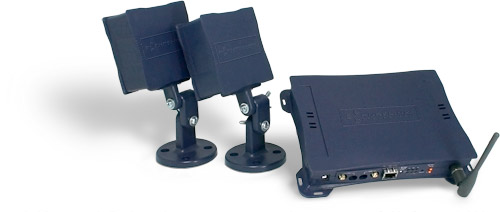RFID requires in addition to the tag two additional components, a reader or interrogator and an antenna. In commercial products the antenna is sometimes combined with the reader into a single unit.
Most RFID tags contain at least two parts. One is the integrated circuit for storing and processing data and modulating and demodulating a radio signal. The second is an antenna for receiving and transmitting the signal.
There are three types of RFID-tags. Active tags rely on a power source such as a battery for operation and can transmit radio signals autonomously. Passive tags relying on an external source providing energy through an electromagnetic pulse, in order for it to run its integrated circuit and modulate a signal that can be transmitted.
The third type is a hybrid of an active and passive tag and are normally referred to as Battery Assisted Passive or BAP tag. The BAP tag depends on an electromagnetic pulse from an interrogator to wake up, and uses its integrated power source to perform its data processing and modulation of radio signals.

From the multitude of proprietary protocols existing for passive Radio Frequency Identification in the 1990's EPCglobal has defined a number of tag air interfaces since then. From Class 0 and Class 1 to the currently approved Class 1 Generation 2 protocol.
In addition to the standardisation, manufacurers have continuously improved both tag, reader capabilities and antenna design. Specialized products now exist to target different physical conditions such as reading at gates, reading omnidirectional, reading tags on fast-moving conveoyor belts etc. New antenna designs on tags has minimized the blind-spot problem that made older tags very diffucult to read from certain angles.
Another important development is the multitude of encapsulations available to date. Conditions that previously was adverse or sometimes impossible for passive tag reading, such as metal containers, containers with liquids, and heat are now handled more adeqately with specialized encapsulations.

Apart from identification, active tag systems are sometimes deployed as Real Time Locating Systems. Depending on the radio frequency used to convey the data between tag and reader different levels of location accuracy can be obtained. Manufacturers supplying ultra -wideband systems provide reportedly sub-meter location accuracy.
Active RFID tags are due to their on-board power supply also often combined with sensors such as temperature- movement- and vibration-sensors.
Standardisation has not reached as far as for passive tags. One ISO standard exists (ISO 18000-7) defining an air interface for an active tag in the 433 Mhz band. Some alliances have been formed by commercial actors among which the ZigBee Alliance is probably the most known.
The bulk of the systems available today however uses proprietary protocols for transferring data between tag and reader, requiring implementations to rely on a single supplier.

